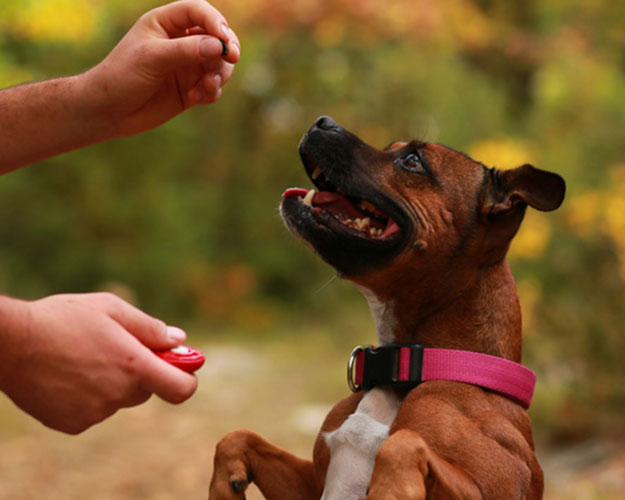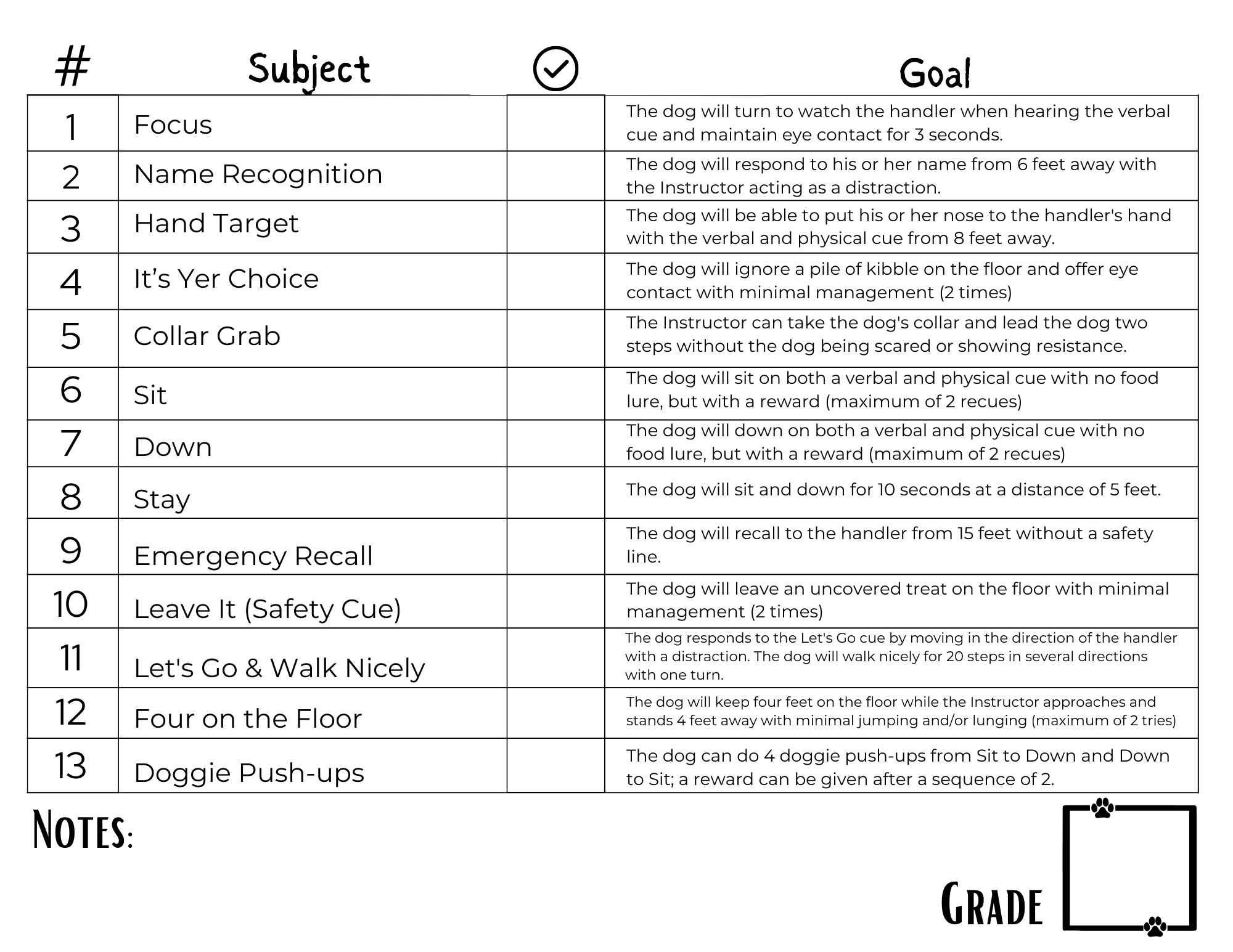Hello Paw-lite Manners 101 Pet Degree Class!
Here is your continued practice Homework for Week 1 of Paw-lite Manners 101.
PLEASE NOTE the goals below might sound like a lot to work on, but your dogs did so well in class that all you need to do is continue to reinforce the behaviors. If you set aside 15 minutes a day (or 3 five minute sessions a day), we are confident that every dog in class will meet the goals with no problem. And if you have any questions at all, please don’t hesitate to ask us by emailing godogsoviedo@gmail.com or calling us at 407-366-6738 during our normal business hours, Mon-Thu 7:30AM-5:30AM.
The skills we worked on in Week 1 are as follows:
- Touch/Hand Target (please see the instructions and video below)
Goal for this week: Your dog will be able to do Touch from at least 6 feet away. Graduates of Puppy Pet Degree: Your dog will be able to do Touch from another room in the house at random. Video: Teaching a Nose Target – Touch Your Hand | By: Donna Hill Learning how to “target” can come in handy for your dog. If you want a dog to move in any direction and he or she knows how to target, you can just move your hand to where you want the dog to go. The criteria is that the dog touches your hand with his or her nose.- Hold your hand directly in front of the dog’s nose. Mark the behavior with (“Yes”) and reward.
- When the dog is consistently putting his or her nose to your hand at least 80% of the time, hold your hand in different positions near the dog (i.e., left side of the face, right side of the face, near the shoulder, out to your side, etc.)
- When your dog is consistently putting his or her nose to your hand from many different angles around the face and body, say “Touch” just before you put out your hand to introduce the verbal cue.
- Increase the level of difficulty by holding your hand in small increments further away from your dog and cue “Touch.”
- Name Recognition (please see the instructions below)
Goal for this week: Your dog will be able to respond to his/her name and move toward you from across the room. Graduates of Puppy Pet Degree: Your dog will be able to respond to his/her name and move toward you outside from 20 feet away. We say our dogs’ names all the time. It’s important to build a positive association to hearing this very special word. If they are ever in a dangerous situation, you will likely say their name first. Practice pairing it with treats at least 5 times a day so that his/her immediate reaction is to turn and come to you when you say his/her name. The criteria is that your dog will not only reorient toward you, but come all the way to you. This is the first step of Recall and it is one of the life skills we recommend you practice for the rest of your dog’s life. One of the most common pitfalls is when we only call our dog’s name when we’re essentially punishing him or her (e.g., bringing them inside, clipping their toenails, putting them in their crate, leashing them up and taking them home, etc.). It may not look like punishment to you, but your dog will start to perceive that coming to you for his or her name means potentially unpleasant things will happen. Perception is really important when training or conditioning a dog because the consequence (good or bad) for performing a behavior will directly affect whether the dog wants to continue doing that behavior. To give your dog a good perception, pair the behavior with yummy, valuable treats. Don’t hold the treat out to the dog. That’s a bribe. Reach for the treat once your dog has come to you. As a follow up, send your dog back to what he or she was doing (as long as it’s safe) when you can. This will teach your dog that coming to you is not only rewarding, but in most cases, it will not permanently interrupt fun.
- Sit and Maintain (please see the instructions below)
Goal for this week: Your dog will be able to do a Sit with only the verbal Sit cue; and with only the hand cue. Graduates of Puppy Pet Degree: Your dog will be able to do a Sit with only the verbal Sit cue; and with only the hand cue while you have a toy in your hand as a distraction. NOTE: Remember the rule when adding in new cues: New Cue before Old Cue. “N” comes before “O” in the alphabet.- With a treat in hand, pinch the food treat between your thumb and finger, so that the dog can smell and lick the treat but not eat it. Hold the treat immediately above your dog’s nose, just touching the nose—do not pull your hand away from his or her nose as this will teach the dog to jump. Move your hand upward to raise the dog’s head. As your dog raises his or her head, the hind end will lower into a Sit. Mark the Sit by saying “Yes,” and then following up with the treat.
- Do this several times until your dog begins to automatically Sit when he or she sees you have a treat and are ready to hold it to the nose. Now begin using a fake cookie. When your dog Sits, follow through with Marking and rewarding.
- You can now teach a hand cue. We do an upward motion that bends at the elbow with your palm facing toward your face. You can start this with the fake cookie prompt and then transition into the upward motion described above. Do this until your pup is able to follow the hand cue without the fake cookie prompt. To add a verbal cue, you can start saying “Sit” two seconds before the hand cue. Over time, your dog will learn that the verbal cue and hand cue are the same thing.
- It’s Yer Choice (please see the instructions and video below)
Goal for this week: Your dog will be able to ignore cookies in your hand and start giving you eye contact before you relinquish a treat. Graduates of Puppy Pet Degree: Your dog will be able to ignore cookies dropped from a foot off the floor and start giving you eye contact before you relinquish a treat. Please NOTE that this is a silent game for the most part. We are teaching our dogs with positive reinforcement (i.e., adding something to increase the likelihood of the behavior happening again) and negative punishment (i.e., taking something away to decrease the likelihood of the behavior happening again). You don’t have to say Leave It or No! or snatch your hand away. The only actions you should be doing are picking up a cookie and hand delivering it to your dog’s mouth when he/she shows impulse control or removing access to the treats by covering them up if he/she moves toward them. This will teach them how to control their impulses around food. Video: It’s Yer Choice | By: Cindy Briggs The following are steps you should take:- Food in hand (close hand if your dog goes for the treats)
- Food in container (drop treat back into the container if your dog goes for it when you reach for the treat)
- Food out of container on the floor (put treat back in the container if your dog goes for it on the floor)
- No container; dropping it or moving it around on the floor (pick it up and start over if your dog goes for it)
- Dropping it from higher heights gradually (pick it up and start over if your dog goes for it)
- Tossing it at them (your dog should not be attempting to steal the treats at this point)
- Experiment with high value treats! (please review the list below and try out different treats)
Goal for this week: Find three primary reinforcers your dog goes nuts for! Primary reinforcers are things that inherently satisfy a basic physiological or biological need, making it inherently rewarding. Examples of these types of reinforcers are food, water, shelter, and sleep. When we are teaching a dog a new skill, the fastest and easiest approach is to use food reinforcement. Food reinforcement can have different values and we recommend using a scale of high to low values in the training process. Use High Value Reinforcements for new and more difficult activities and Medium Value Reinforcements for training sessions where you are recapping information. We recommend keeping all of the high value reinforcers below low fat and low sodium and to break everything into tiny pieces instead of using big chunks.
- Freeze Dried Beef Liver, Chicken, Cheese, or Salmon (we recommend Purebites, but any brand will do)
- Cheese Slices
- Cheeze Whiz
- Turkey Bacon (If no success, you can try regular Bacon)
- Bread Crust
- Cheerios
- Peanut Butter
- Crumbled Ground Beef
- Tripe
- Chicken
- String Cheese
- ZiwiPeak Air Dried Food
- Stella & Chewy’s Toppers or Patties
- Inaba Churu Squeezable Treats
- Steak
- Redbarn Food Roll
- Wet Food in a Squeeze Tube
- Carrots
- Green Beans
- Pumpkin Puree
- Sweet Potato Puree
- Apples
- Strawberries
- Bright Planet Plant-based Dog Treats
- Lean Treats
- Other kinds of treats
- Freeze Dried Beef Liver, Chicken, Cheese, or Salmon (we recommend Purebites, but any brand will do)
- Cheese Slices
- Cheeze Whiz
- Turkey Bacon (If no success, you can try regular Bacon)
- Bread Crust
- Cheerios
- Peanut Butter
- Crumbled Ground Beef
- Tripe
- Chicken
- String Cheese
- ZiwiPeak Air Dried Food
- Stella & Chewy’s Toppers or Patties
- Inaba Churu Squeezable Treats
- Steak
- Redbarn Food Roll
- Wet Food in a Squeeze Tube
- Carrots
- Green Beans
- Pumpkin Puree
- Sweet Potato Puree
- Apples
- Strawberries
- Bright Planet Plant-based Dog Treats
- Lean Treats
- Other kinds of treats
When trying different kinds of treats, we don’t recommend doing this all in one sitting. Try something new every couple of days and only a little bit at a time. Just in case something is not settling well in your dog’s stomach, it is best to introduce new treats and foods slowly.
Bring the high value primary reinforcers to class. At home, it’s okay to use kibble if your dog will work for it. In fact, we recommend you use the lower value rewards at home where there are less distractions so that when you’re in the classroom, you have a higher paycheck to offer.
- We are including your week 7 report card, which consists of all the scales you will be evaluated on in this class. This will help you prepare for graduation
Also attached for your convenience:
Please let us know if you have any questions.
See you in class next week!
Happy Training!




Leave A Comment